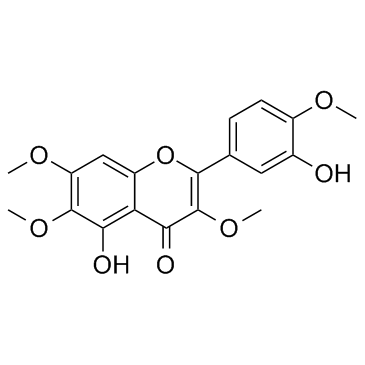479-91-4
| Name | casticin |
|---|---|
| Synonyms |
Casticin
quercetagetin-3,6,7,4'-tetramethylether 3,4',6,7-Tetramethoxy-3',5-dihydroxyflavone MFCD00210481 5,3'-DIHYDROXY-3,6,7,4'-TETRAMETHOXYFLAVONE Vitexicarpin 4H-1-Benzopyran-4-one, 5-hydroxy-2-(3-hydroxy-4-methoxyphenyl)-3,6,7-trimethoxy- Agnus castus fruit Casticine VITEXICARPIM 4H-1-Benzopyran-4-one,5-hydroxy-2 3',5-dihydroxy-3,4',6,7-tetramethoxyflavone 5-Hydroxy-2-(3-hydroxy-4-methoxyphenyl)-3,6,7-trimethoxy-4H-chromen-4-one |
| Description | Casticin is a methyoxylated flavonol isolated from Viticis Fructus, with antimitotic and anti-inflammatory effect. Casticin inhibits the activation of STAT3. |
|---|---|
| Related Catalog | |
| Target |
STAT3[3] |
| In Vitro | Casticin (0.2-1.0 μM) dose-dependently inhibits the proliferation of KB cells, with an IC50 of 0.23 μM on day 3, while shows no significant inhibition on 3T3 Swiss Albino and TIG-103 cells. Casticin (0.6 μM) alters spindle morphology with partial mitotic spindle breakdown or with disordered spindles[1]. Casticin (0-40 μM) dose-dependently inhibits the proliferation of LX2 cells. Casticin (40 μM) suppresses L02 cells proliferation and induces apoptosis. Casticin inhibits fibrotic effects of TGF-β1 on ECM deposition in LX2 cells by evaluating the mRNA levels of TGF-β, collagen α1(I), MMP-2, MMP-9, TIMP-1 and TIMP-2[2]. Casticin (0-8 μM) reduces the viability of 786-O, YD-8, and HN-9 cells, but shows no significant effect on that of the normal HEL 299 cells. Casticin (5 μM) increases cleavage caspase-3 and PPAR, diminishes the levels of B-cell lymphoma-extra large (Bcl-xl), Bcl-2, IAP-1/-2, vascular endothelial growth factor (VEGF), matrix metallopeptidase 9 (MMP-9), and cyclooxygenase 2 (COX-2) proteins in 786-O, YD-8, and HN-9 cells. Casticin (5 μM) also promotes apoptotic cell death, inhibits constitutively active STAT3 in tumor cells, modulates STAT3 activation by altering the activity of upstream STAT3 regulators, and abrogates IL-6-induced STAT3 activation. In addition, Casticin (2.5 μM) enhances the effect of ionizing radiation in 786-O cells and potentiates the therapeutic effect of radiotherapy[3]. |
| In Vivo | Casticin (20 mg/kg, p.o.) has toxic effect on the liver in mice with CCl4-and BDL-induced hepatic injury. Casticin attenuates liver fibrosis induced by CCl4 or BDL in vivo. Casticin inhibits HSC activation and collagen matrix expression by blocking TGF-β/Smad signaling in vivo[2]. |
| Cell Assay | LX-2 cells or L02 cells are plated at a density of 5 × 103 cells per well in a 96-well plate and treated with Casticin (0-40 μM) for 48 h in growth medium containing serum. Cell proliferation is determined using a CCK-8 assay kit[2]. |
| Animal Admin | Mice[2] Male mice 6-8 weeks of age weighing 20-30 g are kept in a temperature-controlled room with an alternating 12 h dark and light cycle. A total of 32 mice are divided randomly into four groups of 8 animals each: control, Casticin, CCl4, and CCl4 + Casticin. To induce liver fibrosis, CCl4 dissolved in olive oil (20%) is injected intraperitoneally into mice (1.0 mL/kg body weight) in the CCl4 and CCl4 + Casticin groups twice a week for six weeks. Mice in the control group and Casticin group are injected with an equivalent volume of olive oil. Casticin is dissolved in 0.25% Tween-80. After treatment with CCl4 or olive oil for six weeks, mice in the Casticin group and CCl4 + Casticin group receives Casticin (20 mg/kg) by gastric gavage daily for two weeks, and the other two groups are given the equivalent volume of 0.25% Tween-80. After the eight week intervention period, mice are euthanatized under 3% pentobarbital sodium anesthesia (40 mg/kg ip), and the livers and blood from all animals are collected. Serum is obtained by centrifugation (1600 g, 15 min) and stored at −20°C for further examination[2]. |
| References |
| Density | 1.4±0.1 g/cm3 |
|---|---|
| Boiling Point | 617.7±55.0 °C at 760 mmHg |
| Molecular Formula | C19H18O8 |
| Molecular Weight | 374.341 |
| Flash Point | 223.5±25.0 °C |
| Exact Mass | 374.100159 |
| PSA | 107.59000 |
| LogP | 2.13 |
| Vapour Pressure | 0.0±1.9 mmHg at 25°C |
| Index of Refraction | 1.640 |
| Storage condition | 2-8°C |
| Hazard Codes | Xi |
|---|---|
| RIDADR | NONH for all modes of transport |


